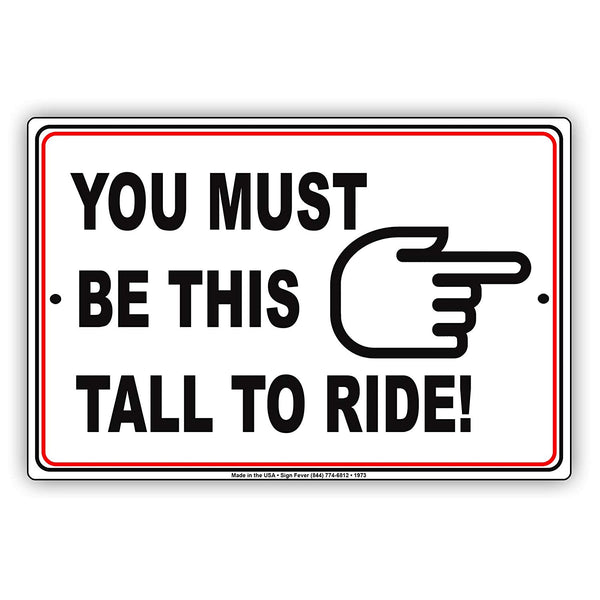Exploring Height Restrictions and Their Impact
Amusement parks are a world of excitement and adventure, offering a variety of thrilling rides and attractions that cater to people of all ages. Amid the colorful chaos and cheerful atmosphere, one sight stands out: the iconic sign that reads “You Must Be This Tall To Ride Sign.” This seemingly innocuous phrase carries with it a multitude of implications, from safety considerations to societal norms and inclusivity concerns. In this exploration, we delve deep into the world of height restrictions at amusement parks, examining their origins, reasons, effects, and potential alternatives.
- Origins and Purpose of Height Restrictions:
The practice of imposing height restrictions on amusement park rides traces back to the fundamental concern for rider safety. These restrictions are implement to safeguard participants from potential risks and hazards associated with certain attractions. Engineers meticulously design rides with specific physical dimensions in mind, considering factors such as the forces of acceleration, the dynamics of loops and drops, and the distribution of weight. Deviating from these intended dimensions could compromise the structural integrity of the ride and pose serious dangers to riders.
- Safety as the Driving Force:
Safety emerges as the primary motivation behind the implementation of height restrictions. The amusement park industry places paramount importance on the well-being of its patrons, and height restrictions serve as a key component of this commitment. In the case of high-speed roller coasters or free-fall attractions, riders are subjected to intense forces that require them to be securely restrained within the ride vehicle. A child who does not meet the height requirement might not be properly secure by these restraints, increasing the risk of ejection or injury during the ride.
- Balancing Thrills and Safety:
Amusement parks aim to provide exhilarating experiences that push the boundaries of excitement. However, this pursuit of thrills must be carefully balance with safety considerations. Height restrictions allow amusement parks to deliver the heart-pounding sensations that visitors seek while maintaining a strict standard of safety. Inverted loops, rapid accelerations, and sudden drops are all part of the thrill package, and adhering to specific height criteria ensures that participants can enjoy these experiences without endangering their lives.
- Impact on Individuals:
The presence of height restrictions has both positive and negative implications for individuals visiting amusement parks.
- Positive Impact on Safety:
The most evident positive impact of height restrictions is the enhanced safety of riders. Families and thrill-seekers alike can enjoy their amusement park visits with the assurance that their well-being is being prioritized. The restrictions contribute to an overall sense of security and trust in the park’s operations, allowing visitors to immerse themselves fully in the experience without constantly worrying about their safety.
- Disappointment and Exclusion:
However, the flip side of this safety-centric approach is the potential for disappointment and exclusion. Children who fall short of the height requirements can feel left out when their friends or family members are able to participate in rides that they are not permitted to enjoy. The enthusiastic anticipation that precedes a trip to an amusement park can quickly transform into feelings of sadness or frustration for those who are unable to participate fully.
- Societal Norms and Body Image:
The “You Must Be This Tall To Ride Sign” can inadvertently contribute to societal norms surrounding body image. The emphasis on height as a criterion for participation can unintentionally convey the message that being taller is superior or more desirable. This can have a lasting impact on individuals’ self-esteem, especially among those who do not meet the specified height requirement. Amusement parks unintentionally become propagators of certain beauty standards, reinforcing the notion that taller individuals are somehow more capable or worthy.
- Alternatives and Inclusivity:
As societal values evolve to embrace inclusivity and diversity, the amusement park industry is also rethinking its approach to height restrictions.
- Ride Redesign:
One alternative to strict height restrictions is the redesign of rides to accommodate a wider range of body types. While this solution might necessitate substantial investment and engineering innovation, it has the potential to make rides accessible to a more diverse group of visitors. By reimagining ride vehicles and restraints, parks can retain the excitement of their attractions while extending the opportunity for participation to a broader audience.
- Virtual Reality and Simulation:
Virtual reality (VR) and simulation technologies offer a promising avenue for inclusive experiences. By leveraging VR, amusement parks can create immersive rides that do not rely on physical height requirements. This approach opens the door to a more inclusive environment, where individuals of all statures can experience similar thrills virtually. Such an approach not only addresses the issue of height restrictions but also aligns with the technological advancements of the modern era.
- Emphasis on Other Factors:
A shift away from exclusive reliance on height as a criterion for participation could involve considering other factors such as weight, body proportions, or medical fitness. A comprehensive safety assessment that takes into account multiple physical attributes could create a fairer system that accommodates a broader spectrum of potential riders.
- Education and Communication:
Enhanced communication and education about the reasons behind height restrictions can also play a role in managing disappointment and promoting safety awareness. When visitors understand the connection between height and safety, they may be more accepting of the limitations imposed by these restrictions.
- Conclusion:
The phrase “You Must Be This Tall To Ride Sign” might seem like a straightforward directive, but its implications extend far beyond the surface. It embodies the delicate balance between delivering thrilling experiences and maintaining rider safety. While height restrictions are undeniably crucial for ensuring a safe amusement park environment, they also reflect deeper societal norms and values. As the amusement park industry progresses, there lies an opportunity to explore innovative alternatives that prioritize both safety and inclusivity. By embracing new technologies, reimagining ride designs, and fostering understanding among visitors, amusement parks can redefine the meaning of the iconic phrase, ensuring that the joy of their attractions can be shared by individuals of all heights.



